- Hair Transplant Repair
- Before & After Photos
- Video
- Answers
- Physician Consult
Hair transplant procedures that exclusively use follicular units leave no visible scarring in the recipient area. In Follicular Unit Transplantation (FUT), there is a single thin line in the donor area where the strip was removed. In Follicular Unit Extraction (FUE) there are multiple tiny round, white scars in the donor area, one for each extracted follicular unit. Generally, these scars are undetectable and are of no cosmetic consequence to the patient.
When older methods are used, current techniques are performed improperly, or less commonly when a patient is a poor healer, scarring may be excessive and may present a cosmetic problem. The scarring may be due to the plug itself (which invariably leaves a round white scar), it may be caused by the elevation or depression of grafts (seen with some slit and minigrafting techniques), or it may be due to a stretched or thickened donor scar.
Scarring in the recipient area can be eliminated by keeping recipient sites very small. Sites less than 1.2 mm, such as those used in FUT and FUE, will not leave any visible marks. Scarring in the donor area can be minimized by meticulous closures, where the wound edges are perfectly approximated and are under little or no tension. Using an inert material to close the wound, such as stainless steel staples, also helps to minimize the destruction of hair follicles and the incidence of hair transplant scarring.
Techniques of Fixing Scars
When significant scarring does result, a number of techniques are available to reduce it. The two most effective methods are scar revision (excising or changing the direction of a scar) and camouflage (a technique where hair is transplanted directly into the scar). In addition, thickened scars may be flattened with cortisone injections, depressed scars may be raised with dermal fillers, and an irregular surface may be made smoother with dermabrasion or laser treatments.
The method for fixing hair transplant scars must be tailored to the specific situation, since each hair transplant repair patient has unique problems which influence the approach. Perhaps the most significant issue is the amount of remaining donor hair reserves. The following examples illustrate a number of common techniques used to improve scarring.
Examples of Scar Repair Methods
Example 1
The open-donor removal of plugs from the donor area leaves round, white scars. If a person has sufficient scalp laxity (looseness), the area where the plugs have been removed can be improved by simply excising these scars in the same manner that a donor strip is removed. After the area is sutured closed, the hair in the excised tissue can be dissected out under microscopic control and serve as a source of additional grafts.
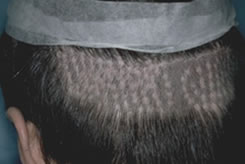
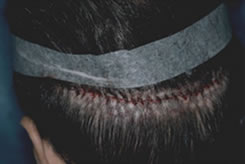
Example 2
The patient pictured below has rows of round scars from the old punch-graft hair transplantation technique performed many years ago. Now that he wears his hair clipped short, these scars are very visible. We removed the two rows of plugs in a single line incision. The excised strip was dissected into individual follicular units and placed back into the scars on the right side of the patient’s scalp. After this redistribution is complete, if additional camouflage of the remaining scars is needed, the hair would be obtained via direct follicular unit extraction from the donor area (FUE), rather than though another linear excision.
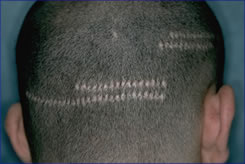
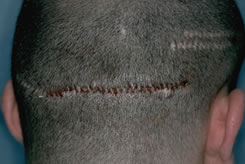
Example 3
The following hair restoration patient had artificial hair sewn directly into his scalp. This procedure is now illegal in the United States due to the invariable scarring that results from the body’s rejection of the foreign hair fibers. The scarred area was camouflaged with two sessions of follicular unit hair transplantation. Fortunately, the patient’s donor supply was adequate enough to cover the scarring. To have the greatest cosmetic benefit from the hair transplant, the highest density was placed at the frontal hairline. In addition, since the blood supply was the least impaired at the hairline, placing the most hair in this area (rather than directly into the area of scarring) will insure maximum growth.
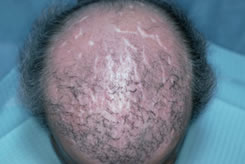
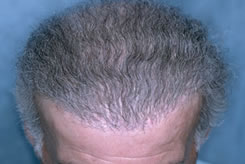
Example 4
A scalp reduction is an outdated surgical hair restoration procedure (popular in the 1970s and 1980s) where the surgeon simply tried to cut out the bald area. Unfortunately, this left the patient with a tighter scalp, a diminished donor supply and a scar on the top of the head and/or in the crown. To make matters worse, over time, the scalp would typically stretch back to its original position resulting in the reappearance of the bald area. See the commentary Are scalp reductions still indicated?
The following patient had a large Y-shaped scar from four scalp reduction procedures. In addition, his donor supply was low and his scalp was tight. The patient was treated with one hair transplant session of 1,825 follicular unit grafts.
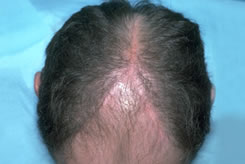
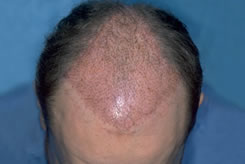
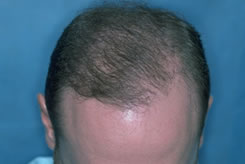
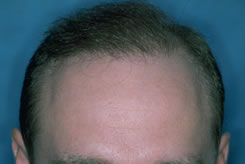
For a comprehensive discussion of corrective hair transplantation procedures read Dr. Bernstein’s paired publications, The Art of Repair in Surgical Hair Restoration: Part 1: Repair Strategies and Part 2: The Tactics of Repair





